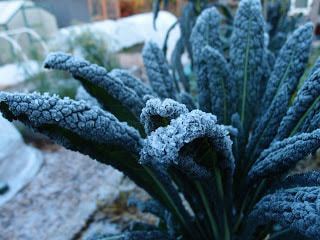In the Maritime Northwest, with only the most basic of season extension techniques, you can celebrate Thanksgiving as a true, local harvest festival.
Kale needs no protection, and looks glorious bathed in crackling frost.
Chard won’t make it unassisted through a snap of real cold (teens/low-twenties around here) but protected by a cheap plastic tunnel cloche can be expected to make though winter about half the time.
Fennel gone to seed can still flavor winter broths and nourish any brave little pollinators who happen out in the cold and snow.
The various hardy vegetables in the cabbage family sweeten with a hard frost. I am loath to eat brussels sprouts from California because they taste like cardboard. My homegrown sprouts, though? Delicious. Like a different vegetable.
As long as we keep their water liquid (i.e., not frozen) the chickens seem unfazed by temps in the mid-20s and shorter daylight hours. We got five eggs from the 7 chickens today.
When I first started gardening, I thought the limp leaves of a frozen cauliflower plant meant certain death. Now I know that wilted look is almost always temporary.
I pile straw and compost around winter crops to keep a freeze from damaging the root system.
Many vegetables will grow right through the average Maritime Northwest winter, and even more can be babied through the worst of the cold and rain with cheap cloches and row covers.
Every year it’s a bit of a challenge to see what I can harvest fresh for Thanksgiving, the canonical harvest feast. This year looks good: beets, kale, chard, rutabaga, turnip, potatoes, cabbage, parsnip, carrot, lettuce, celeriac, mustard and more all made it through the last two nights of freezing temps and will make it to the table on Thanksgiving.
What will you be harvesting for your feast this Thanksgiving?
1

Your garden looks great! What's on the menu for Thanksgiving then? PS – I bought myself some exfoliating gloves recently and have been using them to clean my spuds regularly. Absolutely brilliant – thanks for the tip! 🙂
Thanks Tanya! Glad those gloves are working for you, too. 🙂 I'm still finalizing the menu but I'm thinking rutabaga fritters for sure! And brussels sprouts with bacon, of course!
Wow – everything looks incredible!
HI Erica!
I have a question about your chickens. Could you show me a little more how they are set up? I have ladies too and mine aren't laying any eggs at all! I have 12 and not a darn egg in weeks. Thoughts?
Thanks,
Jennifer
Hi Jennifer – I suspect the reason we continue to get eggs this late in the season is twofold:
1 – the entire roof of the coop is mesh, therefore it lets in a ton of natural light, which of course is what determines laying frequency. This does mean we need to throw a blanket over the top if it threatens to get super cold, but so far we've had mid 20s with no problems and no squacking from the girls.
2 – our chicken are all young. 6 of the 7 are <1 year; the last is <2 years. I think the younger girls just lay more.
I know a lot of chicken keeper who will add in supplemental lighting on a timer into the coop when egg production falls off in the fall. This is certainly something you could think about – there are pros and cons from what I researched.
Here's a link to the coop which shows the mesh roofing covered with clear corrugated roofing panels to keep out the rain. https://nwedible.com/2011/09/coop-improvement-projects.html